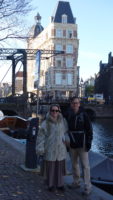 One of the reasons to travel is to see things you either can’t see or would rarely see at home. To wit, I ventured out to get us all breakfast this morning while Mer and Dubbs got ready. Normally, even in the metropolis of Cuyahoga Falls, I do not walk out the front door and get greeted by a canal. Add in mostly deserted streets (on a Sunday morning) and charming buildings and a beautiful day, and you have the makings of an astonishingly great walk. I saw some very cute children in life jackets getting bundled onto canal boats. All very European Normal Rockwell.
One of the reasons to travel is to see things you either can’t see or would rarely see at home. To wit, I ventured out to get us all breakfast this morning while Mer and Dubbs got ready. Normally, even in the metropolis of Cuyahoga Falls, I do not walk out the front door and get greeted by a canal. Add in mostly deserted streets (on a Sunday morning) and charming buildings and a beautiful day, and you have the makings of an astonishingly great walk. I saw some very cute children in life jackets getting bundled onto canal boats. All very European Normal Rockwell.
That is when I was passed by the rollerblading man. Since he came at me from behind (ha!), I did not get to see him from the front, but the backside was certainly in view. The man was wearing a hat, a coat, and a blue thong, and rollerblading. In thirty-six-degree weather. Even in relaxed Amsterdam, he was catching odd looks from the few people out and about.
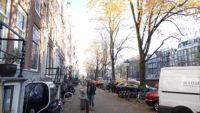
Since many places are closed on a Sunday, I took a circuitous route to a bagel place we had seen on Saturday, to see if there was anywhere else open. Along the way, I passed the Bag and Purse Museum, which I had not known existed. Then, I passed the Waldorf Astoria Hotel, which was tastefully guarded by a large man in an impeccable suit, who I am sure would have politely refused me entrance.
I finally got to the bagel store, where I learned several things: food is expensive in Amsterdam, with bagels running over four dollars each; Europeans spread butter and jams using spoons instead of knives; nude men on magazine covers is considered good possible breakfast reading material. A man at a table was talking about how smells are all frequencies, and went on to expound how all of life is frequencies.
The walk home was uneventful. This was just getting breakfast, mind you.
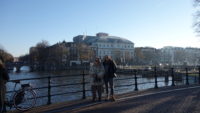 Mer was in charge today, and she wanted to go to church, so we went to church. We may have had one or two or a dozen photo stops along the way. We still made it on time, to an English-speaking service of a Vineyard Church, housed in an old church that had been updated with sound and other A/V equipment, as well as an extensive coffee bar. The people seemed very kind, and it was a good service. We opened with the hymn “Great Is Thy Faithfulness” sung in Dutch, but projected with English lyrics, and then the rest of the songs were all in English with Dutch lyrics projected. The sermon was all in Dutch, but we were provided with headsets to listen to a live English translation, which is always an impressive trick to me. The sermon was on the importance of giving – being willing to give up time and money to serve God, and how God is faithful even when you give. He used a few examples, but one that stuck out was of a friend who was a doctor who gave up what could have been a lucrative practice in the Netherlands to go practice medicine in rural China instead. The doctor is retired and has little money now, but is full of life and joy; he gave away himself and does not regret it at all.
Mer was in charge today, and she wanted to go to church, so we went to church. We may have had one or two or a dozen photo stops along the way. We still made it on time, to an English-speaking service of a Vineyard Church, housed in an old church that had been updated with sound and other A/V equipment, as well as an extensive coffee bar. The people seemed very kind, and it was a good service. We opened with the hymn “Great Is Thy Faithfulness” sung in Dutch, but projected with English lyrics, and then the rest of the songs were all in English with Dutch lyrics projected. The sermon was all in Dutch, but we were provided with headsets to listen to a live English translation, which is always an impressive trick to me. The sermon was on the importance of giving – being willing to give up time and money to serve God, and how God is faithful even when you give. He used a few examples, but one that stuck out was of a friend who was a doctor who gave up what could have been a lucrative practice in the Netherlands to go practice medicine in rural China instead. The doctor is retired and has little money now, but is full of life and joy; he gave away himself and does not regret it at all.
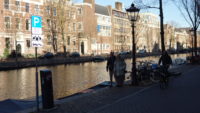
After church, we strolled over to the Rijksmuseum, which is the national museum of the Netherlands. It is enormous. We got a museum pass card that we can use five times in any number of museums around the city, and we signed up for a “highlights tour” for 3:00. That gave us time to eat lunch in the cafe before joining the tour, which was only five of us joining a charming guide who took us on an hour tour of some of her favorite works, which included talking about the building.
The Rijksmuseum was built in the late 1800s as part of a nationalist movement in the newly-created Netherlands, so the building was designed to be a museum. The architect had experience in building cathedrals, and so many aspects of the museum resemble large church buildings, from stained glass to large entrance halls, to Rembrandt’s The Night Watch being in a place where an altar normally would be. In fact, the place was so much like a Catholic church that the Protestant king refused to dedicate the building and never set foot in it.
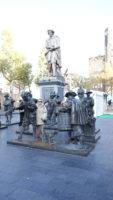 Our guide, Anne, showed us several paintings. One was a beach scene that seemed happy, but she asked us to look more closely and explained more about it, and it was of fisherman’s children who were “Children of the Sea” (the name of the piece), so it was not so cheerful as it may have looked at first. She showed us a painting of a street scene influenced by photography, with the rooflines of the buildings cut off. The central figure was of a woman who originally was a maid, but the painting did not sell, and the artist heeded the advice of some friends and repainted her as a fur-wearing rich woman. The painting then sold.
Our guide, Anne, showed us several paintings. One was a beach scene that seemed happy, but she asked us to look more closely and explained more about it, and it was of fisherman’s children who were “Children of the Sea” (the name of the piece), so it was not so cheerful as it may have looked at first. She showed us a painting of a street scene influenced by photography, with the rooflines of the buildings cut off. The central figure was of a woman who originally was a maid, but the painting did not sell, and the artist heeded the advice of some friends and repainted her as a fur-wearing rich woman. The painting then sold.
We went upstairs to the seventeenth-century room, where we saw a painting of a family party that was out of hand, with even the children smoking and drinking; it had a moral of (more or less) “as the parents do, so will the children.” It seems paintings like that sold very well. We saw an extraordinary still life, and while I am not fond of still life paintings, this one was almost photorealistic. The artist really was showing off, and for good reason.
We finished out tour with Rembrandt – his The Jewish Bride painting from late in his career, with a husband and wife holding hands, but I thought they looked slightly sad. Of course, we finished with the huge and magnificent The Night Watch, which was revolutionary for the time, with Rembrandt’s capturing motion and action instead of stiff poses. We were told the painting was cut back at one point because it did not fit where people wanted to hang it. No one knows where the lost portions went, but the museum has a painted miniature copy of the full canvas, so at least we know what it was supposed to look like.
 That was a grand way to spend an hour, and I like art much better when someone helps me understand the history or symbolism of a painting. We will almost certainly be going back to the Rijksmuseum later in the week, but today we had a 5:00 reservation to see the Anne Frank Museum, which was about a thirty-minute walk away.
That was a grand way to spend an hour, and I like art much better when someone helps me understand the history or symbolism of a painting. We will almost certainly be going back to the Rijksmuseum later in the week, but today we had a 5:00 reservation to see the Anne Frank Museum, which was about a thirty-minute walk away.
You need to have a reservation for the museum, which Meredith booked two months ago, because it is so small. The museum is mostly made up of the building where the Franks and four other people hid for two years before being discovered by the Nazis. That was the most striking thing for me – to see how small the rooms were where the people all had to live together for such a long time. Anne Frank wrote a diary during her time in hiding, and after the war it was published by her father, who was the only person of the eight to survive the concentration camps to which they were all sent.
The presentation of the museum was excellent. We had audio guides that were room-activated, and so would tell us the history of the Frank family and the people who helped them hide. The actual rooms where the Franks and the others lived had no audio guide descriptions, probably to keep people moving through the small spaces. They still had the marks in the wall that recorded Anne’s and her sister’s heights, and still had Anne’s decorations pasted to the walls of her room. It was a moving experience, and very worthwhile.
 We had supper at a nearby pancake place, with the Dutch pancake somewhere between the American version and a French crepe. We took a slow and casual walk back home, enjoying the amazing interiors of the houses that we could see through the large windows, and we loved the various lights playing off the water of the canals.
We had supper at a nearby pancake place, with the Dutch pancake somewhere between the American version and a French crepe. We took a slow and casual walk back home, enjoying the amazing interiors of the houses that we could see through the large windows, and we loved the various lights playing off the water of the canals.
So, whether it is looking for bagels or getting pancakes, travel always gives you food for thought.
“The man was wearing a hat, a coat, and a blue thong, and rollerblading.”
Photos or it didn’t happen!
The major problem with not having a phone….